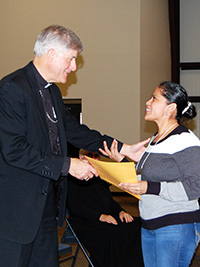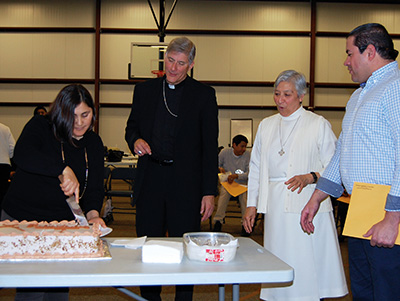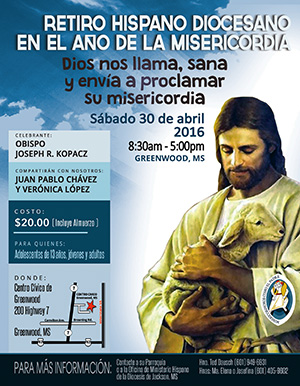SALTILLO, México – Durante su segunda visita pastoral a la Misión de Saltillo en dos años, el Obispo Joseph Kopacz siguió un interesante itinerario repleto con visitas a los ranchos, misas, confirmaciones y dedicando tiempo a comer y hablar con los fieles en esa región del norte de México.
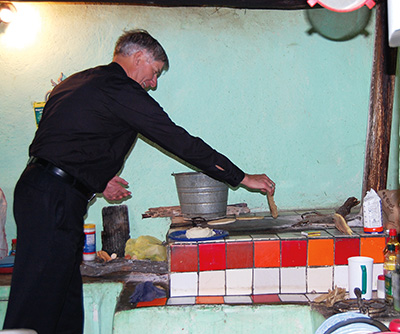
En uno de los hogares, el obispo fue invitado a preparar tortillas. Como no había tiempo, se ofreció a colocarlas en la hornilla para calentarlas.
La razón principal de este segundo viaje a la Parroquia San Miguel fue para la consagración de la nueva Iglesia, la Divina Misericordia, construida en la Colonia Fuentes del Pedregal, un área de Saltillo, donde según el Padre David Martínez Rubio, párroco, viven muchos protestantes y ateos. Ultimamente algunos de ellos han mostrado interés en regresar a su fe católica. Esta capilla proporciona servicios a la comunidad guiada por las 14 obras de misericordia, dijo el Padre Martínez.
Las Diócesis de Jackson y Biloxi han apoyado económicamente y espiritualmente a esta misión en México durante 48 años. Los obispos y un gran número de jóvenes de ambas diócesis han visitado en varias ocasiones esta misión y muchos de nuestros sacerdotes han servido en ella desde entonces.
El sacerdote irlandés Patrick Quinn, de la Diócesis de Jackson, fue su primer párroco comenzando en 1969, quién se ofreció a servir en un lugar cuyo idioma le era desconocido. El Padre Quinn sirvió en la Iglesia Nuestra Señora del Perpetuo Socorro hasta el momento de su muerte el 7 de enero de 1997.
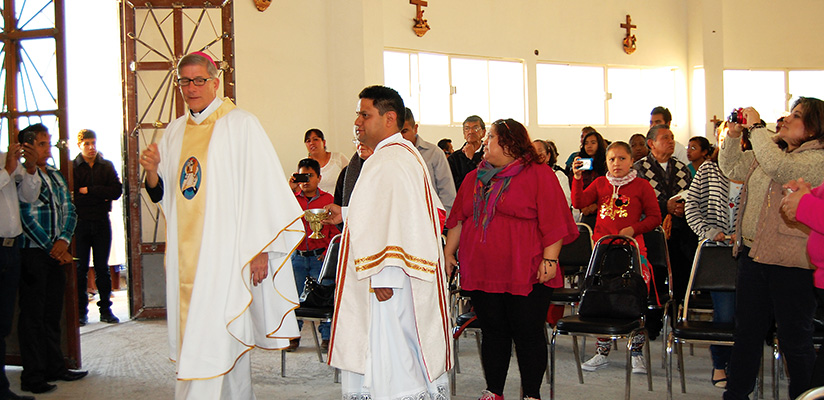
El Obispo Joseph Kopacz camina dentro de la nueva capilla, Divina Misericordia, bendiciendo a la comunidad reunida para la misa de consagración. El obispo también bendijo las Estaciones de la Cruz y prendió las velas de las paredes.
Antes de la misa de consagración de la Capilla (Iglesia) Divina Misericordia la noche del domingo 31 de enero, el Obispo Kopacz recorrió por carretera durante tres días los empedrados caminos del desierto para visitar 13 ranchos que están entre 50 y 80 kilómetros de la ciudad de Saltillo, en los cuales celebró seis misas; una de ellas en “El Cuervo”, un rancho de caza de venados donde fue invitado a pasar la noche junto con sus acompañantes.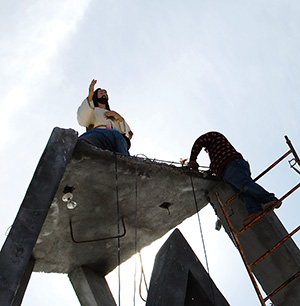
En algunas de las comunidades que visitaron, el Obispo Kopacz, el Padre Martínez y los cinco voluntarios que los acompañaron, fueron invitados a compartir una comida con ellos. Durante las misas, el Obispo Kopacz confirió el sacramento de confirmación a 24 jóvenes en tres diferentes comunidades y en una de ellas bendijo la celebración de una quinciañera. También participó en la “levantada del Niño Jesús en algunos de los ranchos, una tradición católica que representa la presentación del Niño Jesús en el templo, la cual marca el final de la temporada navideña.
Diana Estrada, una de las jóvenes que fue confirmada en el Rancho Nueva Sabanilla el domingo 31 de enero, dijo que se sentía muy alegre porque tuvo la dicha de ser confirmada por el Obispo Kopacz. “Fue una experiencia muy bonita”, indicó. “Lo admiro porque veo que es una persona muy humilde y sencilla y me complace verlo de nuevo”. Ella comentó que lo había conocido la primera vez que fue a Saltillo, en noviembre del 2014, cuando visitó su rancho. En esa oportunidad, miembros de la comunidad caminaron unos cuantos kilómetros p
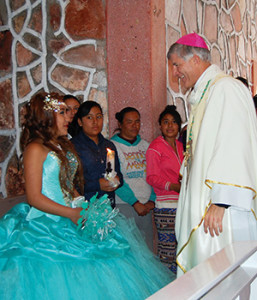
Alondra Carrizales, del Rancho San Pedro, celebró sus 15 años con una misa celebrada por el obispo quien le impartió una especial bendición.
ara irlo a encontrar en el camino. “Me impresionó el hecho de que se bajó de la camioneta y caminó junto con nosotros hasta la capilla.
El Padre Martínez, de 43 años, y el Padre Evelio Casarrubio, 35 años, fueron ordenados en el 2011 en la Diócesis de Saltillo y ambos comenzaron sus servicios en la Parroquia San Miguel trabajando junto con el Padre Benjamín Piovan. Cuando este falleció en agosto del 2014 el Obispo de Saltillo, Raúl Vera, los nombró administradores de la parroquia.
El Padre Martínez dijo que durante el tiempo que trabajaron con el Padre Piovan conocieron la misión de misericordia que el Padre Quinn había hecho en los ranchos y que el Padre Piovan continuó durante sus años de servicio en la Parroquia San Miguel antes de su muerte.
“Es una bendición los tres años que trabajamos con él y aprendimos el ministerio que se hace en estos ejidos”, dijo. “Ahora nosotros continuamos visitando estos ranchos dos veces por mes y en oportunidades especiales cuando se imparten los sacramentos o hay
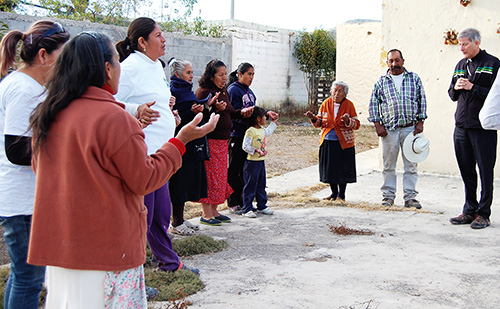
Los habitantes del Rancho San José se reunieron en frente de la capilla para recibir la bendición del obispo y para saludarlo. El obispo igualmente bendijo las capillas y a los miembros de los otros 12 ranchos que visitó.
una celebración religiosa como el Miércoles de Ceniza, o Semana Santa”.
Hay un grupo de laicos comprometidos que son parte de la pastoral rural de la parroquia que los acompañan a los dos sacerdotes en sus visitas a los ranchos, lo cual les facilita el trabajo. Los miembros de esta pastoral se encargan de la catequesis y otras celebraciones especiales.
El Padre Martínez afirmó que esta labor no sería posible realizarla sin el constante apoyo y soporte económico de la Diócesis de Jackson y Biloxi.
Sobre el Obispo Kopacz dijo, “Nos llevamos una sorpresa cuando lo conocimos ya que es un hombre muy sencillo y lleno de misericordia, así lo puedo describir.
“Para nuestros feligreses, y en especial para la gente de los ranchos, es ver claramente el signo mayor de misericordia que Don José (como es cariñosamente conocido el Obispo Kopacz) venga hasta ellos desde tan lejos y que nos venga a decir que no sólo viene su persona sino que toda su diócesis y sus feligreses nos aman, oran por nosotros y nos brindan su apoyo. Es algo así como cuando el Señor te dice, “aquí estoy”, indicó el Padre Martínez.
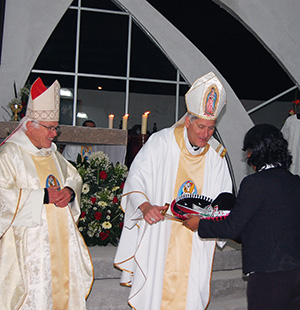
Durante la misa de consagración, (arriba) la Diócesis de Saltillo le ofreció un sobrero mexicano al obispo como símbolo de unión con la Diócesis de Jackson.
“Observamos como Don José visitó los hogares de estas humildes personas sin ningún problema. La gente regularmente se imagina que un obispo viene con guardaespaldas, que es alguien lejano a ellos, que no es capaz de tocarlos o conversar con ellos o que no puede entrar a sus hogares porque sus casas son muy humildes. Tienen esa idea y cuando ven a Don José que entra a sus casas, que toma café con ellos y disfruta una comida en familia, sin ningún protocolo o título eclesiástico, eso conmueve mucho y devuelve la fe, nos hace sentir a Cristo que camina con nosotros, que comparte la vida con nosotros”, explicó el Padre Martínez.
Durante su primera visita en el 2014 el Obispo Kopacz bendijo junto con el Obispo Vera la primera piedra de la construcción del templo y les prometió que volvería en un año para bendecirlo.
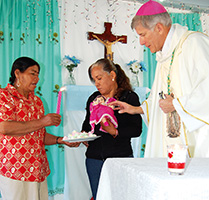
El obispo bendijo la levantada del Niño Dios en el Rancho Nueva Sabanillas y en varias comunidades.
El nombre que se le dio al templo fue escogido antes de que el Papa Francisco anunciara el Año jubilar de la Misericordia. “Eso nos dejó a nosotros sin palabras. No es casualidad, en el fondo, creo que Dios está presente y ha hecho participe a Don José de este proyecto”, anotó. “Y le agradecemos sus oraciones y su presencia en medio de nosotros”.
(NOTA: Vea más fotos en la edición en ingles)
